

During the past week, our class has read two short stories, "Cathedral" and "Everyday Use". Both of these stories have their own unique significances and meanings.
In "Cathedral", the unidentified narrator is described as a simple man who has little understanding of anything that is not a direct part of his life. For example, his mental of image of and information on blind individuals is almost completely based what he has seen in movies. He doesn't understand how a blind man can truly love a woman whom he has never laid eyes upon. Towards the end of the story, the narrator has his "eyes opened" to how "blind" he had been when asked to describe a cathedral to that same blind man. Unable to give an adequate description with words, he instead was asked to draw the structure. Though he claimed his drawing was "not very good", the blind man encouraged him and guided the pencil with his hand. During this moment, the narrator was able to "see" the beauty of the structure as the blind man did.
The author of this story is trying to convey to the readers the idea that we often take things like our eyesight for granted. Those of us who are given this gift more times than not do not use it to its full potential and fail to see the simple beauties of the world. We can look an object and still not be able to give a description that gives justice to its appearance as the narrator had. What we all should take away from this story is to realize that there is beauty in everyday life is we only take the time to realize it's there.
The main theme "Everyday Use" deals with how to honor one's heritage. The character Dee was never satisfied with her life with her family. She had a haughty demeanor and felt she made for better things. Leaving home and going into the world on her own was probably one of the happiest moments of her life. However, one day she returns sporting a new fashion style stylized after African clothing. She had decided to change her name to an African-sounding one to cast off the one given by "the slave owners". She believes the heritage of her African ancestors is her "true heritage". Later on, Dee wishes to take two quilts from her mother that were made by her grandmother in order to properly "honor their heritage". However, her mother decides to give them to her younger sister Maggie. Enfuriated, Dee storms off telling them using the quilts is not way to honor their past.
This story brings up several interesting points I would like to address. First of all, I feel that Dee's desire to find her roots is not entirely genuine. It seems like she is just following a fad in order her separate herself from "the masses". The fact that she seemed to always want to be part of the "elite group" with her condescending nature supports this theory. Secondly, I do not see how the usage of a semi-worn quilt dishonors the ones who made it. As long it still in serviceable shape, using the quilt is best thing you can do with it. Thirdly, the idea of what one's true is, is quite intriguing. Personally, I believe one's heritage consists of the culture and history of all ancestors no matter what country they lived in. For Dee and her family, their "true heritage" is a combination of the heritage of their ancestors in America and Africa. Finally, the fact that both of the quilts went to Maggie instead giving one to each of the two daughters helps support the message the author tries to convey. Though it would make perfectly logical sense for each to receive one quilt, doing so would have given the story a neutral tone in this manner.




No comments:
Post a Comment